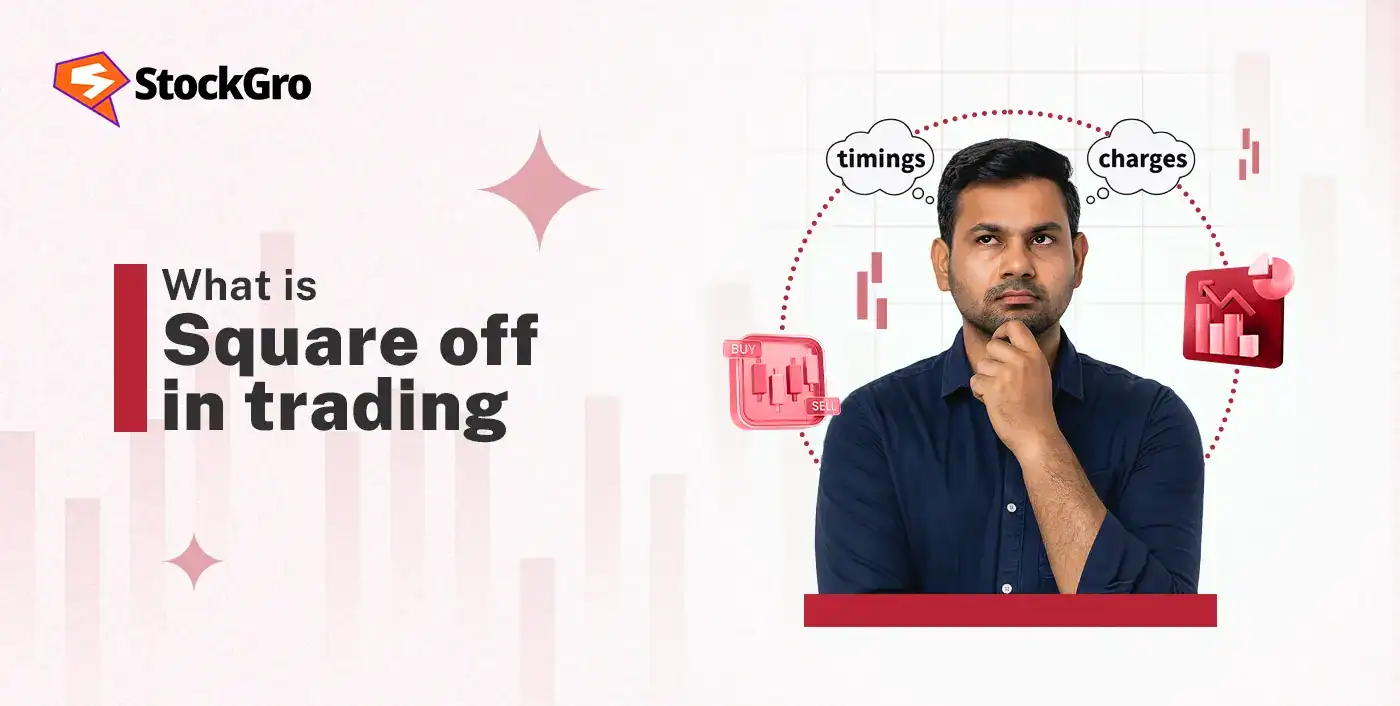
Every trading day, traders jump in and out of stocks to make the most of short-term price movement. These moves not only affect individual portfolios but also shape the overall market’s rhythm and volatility. In order to end the day with profits or losses in check, there’s one key move every trader makes, which is to square off.
Square off is a trading style used by traders, usually in day trading, in which a trader buys or sells a quantity of an asset and later in the same day reverses the transaction, hoping to earn a profit.
Read this blog to explore the square off meaning in the stock market, auto trade square off, square off timing, and more!
What is square off in trading?
Square off in trading means closing an open position by taking an opposite transaction of equal quantity to exit a trade and lock in profit or loss.
Square off is more about capturing the profit, rather than making a profit. Let’s understand with an example!
Let’s say a trader bought 100 shares of Tata Capital Ltd. at ₹1,000 per share in the morning, so he owned shares worth ₹1,00,000. Then, by the afternoon, the share price goes up to ₹1,200, so the trader sells his shares at ₹1,20,000, which is called square off in trading. The trader closed their trade by doing the opposite action, which locked a profit of ₹20,000.
That’s the selling part, what about buying to lock in profit? Let’s say the same trader sold 100 of TCS Ltd. shares at ₹1,200 per share in the morning, a condition called short selling, where a trader sells the shares without owning them. By afternoon, the share price falls to ₹1,000, and the trader immediately buys them to earn a profit of ₹20,000.
How does Square Off work in Intraday Trading?
When a trader doesn’t manually square off their trades, the broker’s system will automatically do it, usually around 3:20 PM or before the market closes, and they will charge a fee for this service. Let’s see how intraday square off works!
- Long Position: In this scenario, a trader buys shares and then sells them on the same day to close the position and book profit or loss.
- Short Position: Here, the trader short sells, sells shares they don’t own, and then buys them back on the same day to close the position.
- Auto Square Off: The brokers have a mandatory cut-off time, around 3:20 PM, to close all open intraday positions. It prevents the positions from being carried over to the next day and protects against overnight risks.
- Auto Square Off During Volatility: The risk management system of the broker’s platforms may automatically square off a position if the price moves against the trader by a high percentage to limit losses.
Auto Square Off Explained
Auto square off in trading is a process where the brokers automatically close an intraday trading position before the market closes, using the Margin Intraday Square-off (MIS) order type.
It ensures all intraday positions are closed by the end of the trading day, which prevents them from being carried over to the next day. This helps in managing risk for both the trader and the broker.
The brokers also implement auto square off in case a position moves a certain percentage against the trader, as a form of risk management.
Square Off Timing in the Indian Stock Market
Check out the square-off timing in the Indian stock market:
| Segment | Auto square off timing |
| Equity/Cash | 3:20 PM |
| Equity/Index Derivatives | 3:25 PM |
| Commodities | 10 mins before the market closes |
| Currency | 4:45 PM to 4:50 PM |
Please note that the stock market square-off time varies across different brokers’ platforms, and there is no regulatory stated timeline for squaring off trades.
Charges Associated with Square Off
In case of auto square off in the stock market, the square off charges include brokerage fees on both the buy and sell orders, statutory charges such as Securities Transaction Tax (STT), Stamp Duty, and SEBI Turnover Tax, and auto-square off penalties of approximately ₹50 + GST per order,in case a trader fails to close their intraday position.
Square Off vs Delivery: What’s the Difference?
Let’s compare Square Off vs delivery to understand how each trading style works and what sets them apart in terms of strategy, risk, and commitment.
| Features | Square off | Delivery |
| Holding Period | The trade positions are closed within a single day | The positions are held for long-term, usually weeks or months |
| Purpose | It locks in profit and losses, based on daily short term price movement | It benefits from long-term growth,and profit over time. |
| Capital Requirement | It requires only a margin, that is a small portion of total value of asset, to trade with leverage | It requires full payment of the entire investment value |
| Risks | It involves higher risk, due to short term market volatility | It involves lower risk, as the market can recover from short-term downturns in the long run |
| Ownership | Traders do not take the ownership of the shares, and only trade them to make profit | Here, the ownership is transferred to the traders, and are delivered to their demat account |
| Commitment | It requires constant monitoring to close trade before the market closes | It is less time consuming and do not require constant monitoring |
| Broker Action | If the intraday trade is not closed by the trader, the broker automatically square it off at the end of the day, and charges a fee for it | There is no automatic square off, traders can hold it until they want |
Tips to Manage Square Off Effectively
- Using Predefined Exit Orders: The traders can set entry and exit points for each trade before entering the trade, such as stop-loss orders, take-profit orders, and trailing stop-loss orders.
- Actively Monitoring Positions and Market Conditions: The traders must stay informed of the market conditions, monitor margin status to avoid being squared off by brokers due to margin shortfalls, and avoid emotional trading.
- Executing the Square Off Before the Broker’s Deadline: The trader shall ensure to manually close their positions to avoid squaring off by brokers, by knowing their broker’s timing to avoid a last-minute rush and extra charges or penalties.
Conclusion: Mastering Square Off for Successful Trading
Square off is an inevitable part of intraday trading that helps traders manage risk, secure profits, and maintain control over their open positions. Understanding its timing, charges, and how it differs from delivery trading enables the traders to make effective decisions and execute the trades better. When it is managed well, square off clears the path towards consistent, disciplined trading success.
FAQ‘s
Square off in trading means closing an open position by taking an opposite trade of the same quantity to lock in profit or loss within the same day.
In intraday trading, the traders buy and sell stocks or contracts within the same trading day, and to exit, they take the opposite trade. That is, they place a buy order if they sold earlier and a sell order if they bought earlier, before the market closes.
Auto square off in trading happens when the broker automatically closes all open intraday positions before the market closes, usually around 3:20 PM, to prevent overnight exposure, when the trader does not manually close them.
A trader should square off their position before the broker’s cut-off time or when their profit target or stop-loss level is reached, to avoid unnecessary risk or penalties.
If a trader does not close their trade in case of intraday trading, the broker will automatically square it off before the market closes and charge a small fee for doing it.
Yes, square off involves brokerage fees on both sides of the trade. Statutory charges like STT and SEBI tax, and an auto square-off fee of around ₹50 plus GST, are charged if the trader misses closing positions manually.
Traders can avoid auto square off by tracking their broker’s square-off timing and manually closing their trades on time, or use stop-loss and take-profit orders to exit automatically before the deadline.

